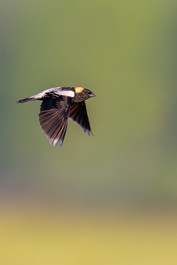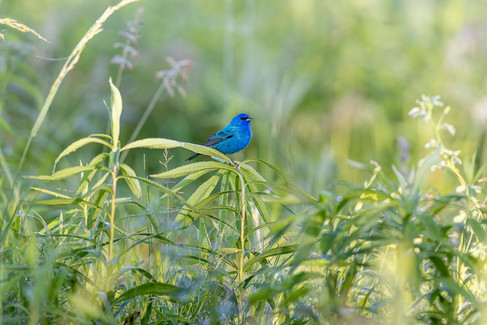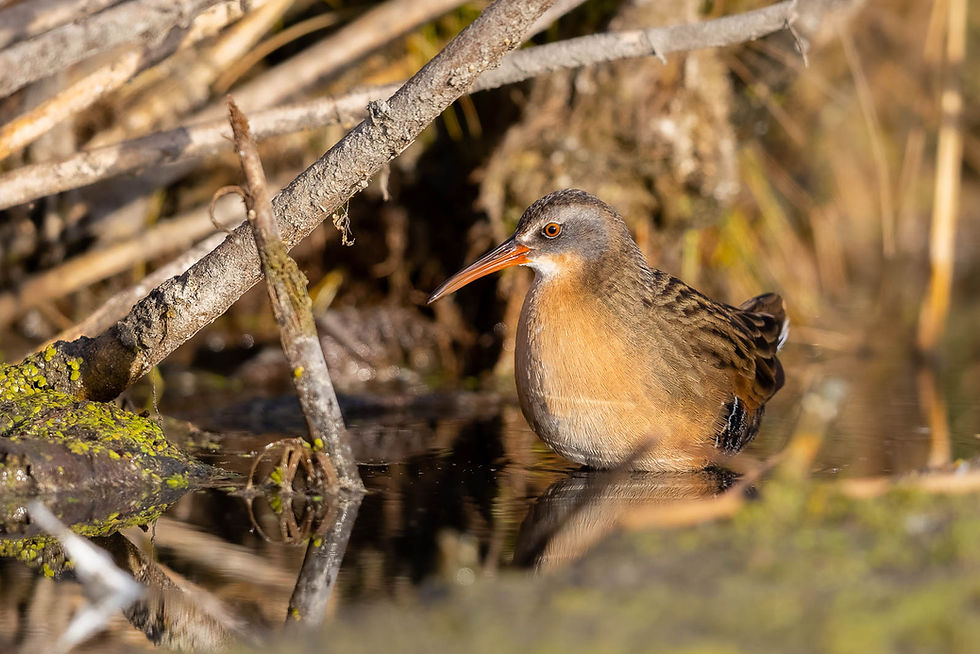Dismal
- Mike Timmons
- May 21, 2024
- 10 min read
5/21/2024
May is wrapping up, and I feel like it was hardly ever here. The following collection represents the past two weeks of effort. I have been working late through the week to squeeze in extra time to bird later in the week and then birding the weekends. Migration has largely been nonexistent here in central Indiana. I have not been alone when voicing my concerns about how few passage migrants were seen this spring. As we moved into middle May, I focused my efforts on finding migrant warblers. This was "peak" season for them. I heard very few and saw even less. Other than a few Tennessee Warblers, most were not even down at a level where they could be photographed. Even fewer were remotely cooperative. Last weekend, I attempted to rescue my spring migration, again, by heading north. Surely I could pull out some photos at lakefront during the Dunes Festival. Unfortunately, things there were as slow as they were here. It was great to see and catch up with everyone. I had only planned to spend a single morning there; with the hope that it would be good enough to tempt me to stay a second day. I left a little before noon. The following day, I hung up my hopes for warblers and started focusing on grassland species. Even that came with its own set of disappointments.
The weekend of the 11th, I spent birding Eagle Creek Park. There are a variety of places to bird there, and it has always provided some of my better photo opportunities for migrants. By this I mean birds that are actually passing through the state vs. those that have migrated here to breed. At this point, most of the state breeding birds are nesting or raising young, and I do not like to disturb them during this time of year. So, I focused on finding birds moving further north. In this category, I photographed exactly two species well enough to share.
Of note this weekend was a single Mourning Warbler, a Canada Warbler, and a Wilson's Warbler. I did have a few Blackburnian up high. Only a couple Chestnut-sided, though. Blackpoll could be heard, but I failed to see one. Lots of Tennessee, but they are not overly responsive to pishing. There were also quite a few Magnolia. Not bad, but I am catching singles of birds where there should have been many. I do not recall hearing a Black-throated Green this weekend. I totally missed Black-throated Blue this spring. No Orange-crowned this year, either. I also missed Bay-breasted and Cape May.
Overall, it is the worst spring migration I have experienced. I would love to know what happened. I do know that there were a large number of storms both below us and over us most of migration. We also experienced a lot of north winds. Maybe this pushed birds around us or what. I do know that even Magee Marsh experienced a fate similar to ours. Migrants showed up and then suddenly disappeared. Birdcast, the migration forecast tool from Cornell, often showed heavy migration to the west of Indiana - out toward the Mississippi River. It is possible the birds primarily moved through there. Again, I would love to know what the real issue was. I have my hopes. I have my fears.
Regarding the weekend at Eagle Creek, I really only have a few other photos to share. I birded a lot of the park; leaving some of the more traditional locations and birding other areas in an effort to locate something. My efforts did not really pay off.
All I could think of all week was how I was having similarly bad luck last year and went to lakefront for a fantastic day of birding. I was set on going again this year. Friday, I packed up clothes for a night and headed north. I arrived in Chesterton about 3PM and waited out the midday sun until about 5 PM. At this point, I headed over to Reynolds Creek to check out the grasslands. They were extremely grown up. In fact, the pullouts were even grown up in grasses. I headed over to the white barn area, but there were tractors there moving around large pieces of farm equipment. I bailed and headed over to the Heron Rookery. I had planned to bird there the following day, but was close by and would serve as a backup plan. Even in the dry years, this place is a bit muddy and prone to mosquitoes. This is not a dry year. I did not bring bug spray. I made it about 200 yards before I had to head back. The constant swarm and number of bites I got were making it impossible to bird. In my short time there, all I heard was some American Redstart and Yellow Warblers. Other birders I passed indicated it was slow there. So, I am not sure I missed much. My last hope for the day was to head into the state park. I wanted to pick up a pass, anyway. I headed in and made my way to the famous Prothonotary Warbler nest box. I walked out along Trail 9 a ways. It was quiet and still a bit buggy. I pished a Scarlet Tanager in overhead but did not have much else. I headed back out to the boardwalk to wait out the rest of the daylight. I did have Prothonotary Warbler, but it did not come up for a shot. Yellow Warbler and American Redstart (it was banded, but I do not have enough photos to get more then a couple numbers) were in the surrounding button bush, as well. While trying to pish in the Redstart, a Red-eyed Vireo came by for some photos. I birded out along the parking lot and over to the small wetland near the shelter. I heard a Blackburnian up in the trees but had little else of note.
The next morning, I was up and at Cowle's Bog before sunrise. This was where I was going to start my rescue plan for saving migration. In years past, I remember the parking lot at the bog being closed until later in the morning; so, I parked at the lot at the beginning of the road. This would allow me to bird the bog in first light and then hit the trails in the woods when the sun was a little stronger. It seemed like a reasonable plan, and it started well. Not that there were many migrant warblers or sparrows along the road. In fact, there were none. Common Yellowthroat and American Redstart were seen. Great-crested Flycatcher and Eastern Kingbirds called from the treetops. Tree Swallows flew about and perched on the wires. Song, Savannah, and Swamp Sparrows called from the brush. I did have a couple Willow Flycatcher singing nearby. A family of Sandhill Cranes greeted the rising sun with their trumpeting calls. Sora and Virginia Rail skulked about in the vegetation. A single Marsh Wren belted out its staccato song.
Of this, the Virginia Rail was my best experience of the morning. I was looking for the Willow Flycatcher when I caught some movement and looked down. There, about five foot from me, was a Virginia Rail feeding in a small stand of flowers in the water. It was slowly moving among the base of the stalks and picking at something. Photographing involved a lot of me moving back and forth to find a clear (or somewhat clear) shot. Anytime the bird got close to an opening, it hit roadrunner mode and sprinted to the next bit of cover. Getting too low meant trying to shoot through grass. Standing up meant... well, not the most favorable of shots. It was a lot of kneeling and shuffling about. As I was standing to move, the bird suddenly stopped, opened its beak, and choked out its grunt-like call. It was a pretty cool experience.
Not that this is a bad thing, but this was the birding highlight of the day. I spent about an hour birding down the road; this includes a bit of backtracking to get the bug spray I bought the night before. I got down to the trails and was immediately struck by how quiet it was. In short, I walked the trail down to the boardwalk and back. In this time, I heard a single Blackpoll Warbler. I had zero thrush or even a vireo. No Ovenbirds. There were a few Redstarts about. There were Yellow Warbler. These are not what I was looking for. I fell into fail-fast mode and quickly birded my way back to my car. I was going to head to the state park, but I was informed that it was dead there. A Connecticut Warbler had been heard on Furnessville Rd; so, I headed there. I drove the length of it but did not hear one. It was much birdier here, and I heard a good number of warblers. I have never been sure about parking on this road, though, and looked for a different location. I finally remembered where to find the spot I had birded last year and headed there. I had high hopes of digging out a Mourning Warbler. When I arrived, I found a tour group there. They had just finished shooting some tiny Virginia Rail babies. I also ran into Lisa and Randy Vanderbilt. I always enjoy birding with them. They were not having much luck that morning, either. We talked and birded around a bit. Eventually Shari McCollough showed up, and it was good to catch up with her, too. We all birded the area a bit but did not come up with much. Best bird was an active Hooded Warbler. A Wilson's Warbler could be heard singing nearby, but it would not pish out of cover. As we walked back toward the car, four tiny black dots rushed across the road followed by a Virginia Rail. The babies had come out of cover and crossed the road. We rushed up, and I managed to grab a shot of a young bird lagging behind. They are so cute!

It was pushing toward midday at this point, and I said my goodbyes before heading home. It was a good trip, but it was not the trip I had hoped for. If nothing else, it is always good to catch up with some of my birding friends.
This brings us up to last Sunday, the 19th. There is still two weeks left in May, and I have decided to give up on migration. This means it is time for some grassland birding. I knew Bobolink would be back, and I decided to get an early start on photographing them. I arrived at Atterbury shortly before sunrise. A layer of fog laid over the field. More concerningly, there were four port-o-pots there. This brought back memories of the time they ran a festival there. With the habitat restoration efforts, I could not picture them doing that again. Large ruts were carved into the dirt next to the road. Some large tractor had been here and through the field since I was here a few weeks ago. It had been through a lot of the field and carved ruts in places there, too. I am not sure what was done, but I know what is planned. More on that in a minute.
Whatever happened here, it had a quieting effect on the field. There were plenty of Bobolink about. That was good. The fog had dampened the calls from the field when I first arrived, and I could not hear anything. I waded out into the grasses and was immediately drenched from the knees down. Once out there, I could hear and see the Bobolink. Oddly, there were not many Henslow's about. I think I had about 4 birds. This is less than what I had during my earlier visit. Most shockingly, there were zero Grasshopper Sparrow. This place is one of the best for this species. It appears this year there will be none. I trudged around chasing Bobolink most of the morning. Anytime I approached a Henslow's, it would stop calling. I only saw a couple fly for cover. None were perched. Other birds included Eastern Meadowlark, Red-winged Blackbird, a few Barn Swallows, and Indigo Bunting.
About those plans.... Well, I feel pretty naive to believe that this habitat restoration was ever about setting aside land for some altruistic reason. My first clue should have been the presence of Northern Bobwhite last year. These had obviously been introduced. They were calling throughout the morning. The bigger clue this time was the constant call of Ring-necked Pheasant. This was new since my last visit. The place is being converted for game bird hunting. In fact, I ran across a pheasant on the road. It was too tame to run off or fly away. It just watched me a pecked at the ground While I was there, a pair of vehicles pulled up. One had dogs with them. Luckily, they noticed me and headed elsewhere to run their hunting dogs. I guess the plan is going to be to open the area for hunting. They hunters can come out and have their dogs run up the game birds and then shoot them. The whole thing seems akin to shooting animals at an overgrown petting zoo. It is pretty sad, if you ask me. Its not even that big of an area. I wonder if the activity here is what has reduced the number of Henslow's and kept the Grasshopper away.
I headed out and birded around a bit. I was looking for Prairie Warbler. I had one calling from a field before sunrise, and I was hoping it would be perched up somewhere. No joy. However, I did end my weekend on a high note.
I have been birding parts of Indiana since I was was a kid. I have been around just about every part of this state. I have never seen a Bobcat. I have seen pictures of Bobcats from places I have been. Somehow, photographing a Bobcat has always seemed like a bit of a holy grail, to me; like finding one is part of some unspoken right of passage for qualifying as a wildlife photographer - hobbyist or otherwise. Well, I pulled into a parking lot to check out an area and looked across the pond. There, silhouetted along the far shore was a large cat-like shape. I grabbed my binocs and looked on in disbelief. There was a Bobcat sitting there staring at me. I pulled out my camera and snapped some shots. It sat there. It was about 50 yards away and backlit. It was also on the other side of the pond; so, I thought, wrongly, that it might sit tight while I got a bit closer. As soon as I got out of the car, it stood up and wandered off into the grass. It is really hard to be disappointed. I would have loved a better shot, but it was really good to see this cat. It has been a long time coming.

With another migration in the books, I will continue to refocus efforts on grassland species. The weather looks terrible this weekend, but that could change. I also need to work out my photo for my May entry for the photo challenge I am participating in. I had hoped for a nice shot of a singing migrant warbler. I will have to settle for something else. More about that in a later post; including an update on last month's submission.
Thanks for reading,
Mike















































































Comments